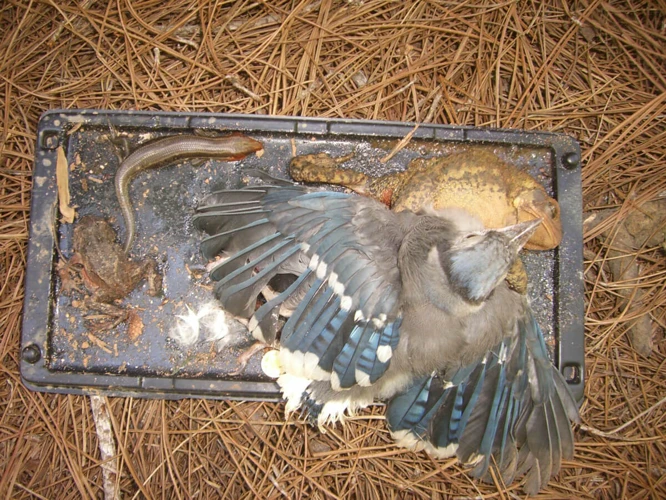Glue traps are a common method used in households and gardens to control pests. Unfortunately, these sticky situations can sometimes inadvertently ensnare creatures we never intended to catch, such as lizards. Understanding how these situations occur and the impact they have on these reptiles is the first step in dealing with the problem effectively and humanely.
How Lizards Get Stuck on Glue Traps
Lizards, often in pursuit of insects, may unwittingly wander onto glue traps. These adhesive boards are designed to be irresistible to pests, but their indiscriminate nature means that any small animal can become a victim. The lizard, attracted by the scent or the movement of insects already caught, steps onto the sticky surface and is ensnared.
The Impact of Glue Traps on Lizards
The consequences of a lizard stuck on trap can be dire. The adhesive is incredibly strong, making escape nearly impossible for the small reptile. Struggling to free itself can lead to stress, dehydration, and even severe injuries. It’s crucial to act swiftly and responsibly to mitigate these impacts and ensure the well-being of the lizard.
Safe Removal of Lizard Trap
When you discover that a lizard has become the unintended captive of a glue trap, knowing how to safely remove lizard from glue trap is essential. This process requires patience, care, and the right technique to ensure that the lizard is not harmed further in the removal process.
Prepare for Lizard Glue Trap Removal
Before attempting lizard glue trap removal, it’s important to gather the necessary materials and mentally prepare for the task. You’ll need:
- A few drops of vegetable oil or mineral oil
- A pair of gloves to protect your hands and the lizard
- A soft spatula or credit card for gentle leverage
- A container with a lid for safe transport after removal
Approach the task with calmness to avoid alarming the already stressed reptile.
Step-by-Step Guide to Remove Lizard from Glue Trap
The process to free lizard sticky trap is delicate and requires a steady hand. Here are the steps to follow:
- Gently cover the lizard with a lightweight cloth to keep it calm.
- Apply a few drops of oil to the areas where the lizard is stuck.
- Wait a few moments for the oil to soften the glue.
- Using the soft spatula or credit card, slowly and carefully lift the lizard away from the adhesive.
- Place the lizard in a prepared container with air holes for recovery.
Patience here is key; never rush the process as this could cause harm.
Non-Toxic Glue Trap Solutions for Lizard Rescue
For those who prefer non-toxic glue trap solutions, household items such as cooking oils can be an effective alternative. These substances can weaken the adhesive enough to help lizard glue trap without causing additional stress or toxicity to the animal.
Humane Lizard Trap Release
Once you have successfully removed the lizard from the glue trap, it’s important to consider the best approach for a humane lizard trap release. This step is critical to ensure the lizard’s survival and return to its natural habitat.
Techniques for Humane Release
Choose a safe, quiet outdoor area away from domestic pets to release the lizard. Ensure that the environment closely resembles the lizard’s natural habitat and offers plenty of hiding spots. Release the reptile gently and observe from a distance to ensure it moves away safely.
Helping the Lizard Recover Post-Rescue
After the rescue lizard adhesive trap ordeal, the lizard may need time to recover. If you notice any injuries or if the lizard seems lethargic, it’s best to contact a wildlife rehabilitator or veterinarian for professional assistance.
Lizard Trap Escape Methods
While the immediate concern is to rescue the lizard, it’s also beneficial to consider lizard trap escape methods to prevent future incidents. Being proactive can save many lizards from the distress of getting trapped.
Different Methods to Free Lizard from Sticky Trap
There are various ways to approach this problem, from modifying the use of glue traps to deploying lizard-friendly repellents. Some people have had success with creating barriers around the glue traps, while others suggest using traps that only target specific pests.
Preventing Future Accidents: Alternatives to Glue Traps
Preventing future accidents involves considering alternatives to glue traps. Options such as electronic repellents, natural deterrents, or simply sealing entry points to your home can be effective. Encouraging natural predators of pests in your garden can also help maintain a balanced ecosystem without resorting to harmful traps.
If you’ve ever faced the unfortunate situation of having an animal stuck to a glue trap, you know how distressing it can be. While our focus here is on helping you with tips on how to get a lizard off a glue trap, our resources don’t stop there. For cat owners, we have detailed guides on how to get a glue trap off your cat and specifically how to remove a glue trap from a cat’s paw. Additionally, if you find a bird in this sticky situation, our article on how to get a bird out of a glue trap can provide you with the necessary steps to safely assist the feathered friend. Each guide is designed to help you navigate these challenging scenarios with care and compassion.
Conclusion: The Importance of Responsible Pest Control
Dealing with pest issues is a part of property maintenance, but it’s vital to do so responsibly. When utilizing pest control measures, always consider the implications for non-target animals such as lizards. By adopting safe removal lizard trap strategies and humane release practices, we can ensure that our methods of pest control are not detrimental to the well-being of these harmless and beneficial creatures. Let’s strive for a balance where our homes are pest-free, and wildlife is respected and protected.

